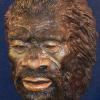Trying to describe a "Typical Bigfoot" would be akin to lining up one human from each of the racial, ethnic, and tribal groups in the world and trying to describe a "Typical Human".
There is one part of a BF's body that, as far as I know, has never been described except by two men from two well separated states in the Southeast. Both have had several, very close-up looks at both types, "Reds" and "Blacks". Overall, there are very noticeable differences between the two types; and distict differences between indivudals in each group, just like the differences in humans.



